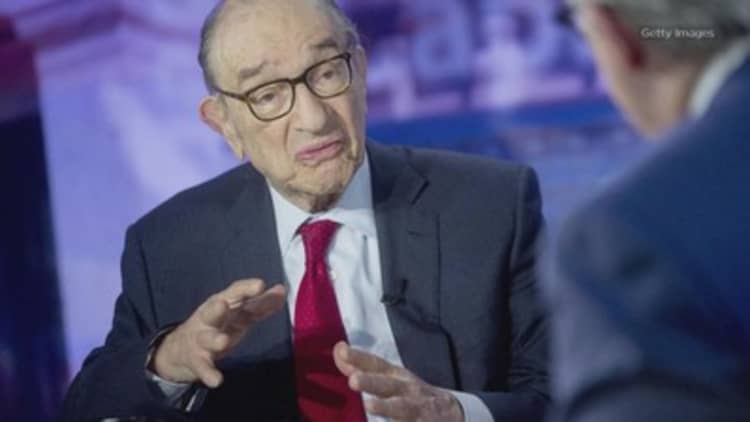
Alan Greenspan, the former Federal Reserve chairman who has a knack for saying memorable things about the markets, is warning of a bond bubble.
"By any measure, real long-term interest rates are much too low and therefore unsustainable," Greenspan told Bloomberg News in an interview. "When they move higher they are likely to move reasonably fast. We are experiencing a bubble, not in stock prices but in bond prices. This is not discounted in the marketplace."
The economy is about to enter a phase of rising inflation, and that sets up the bond market for overheating if it continues. Already Treasury yields have fallen so much there doesn't seem to be room to go lower. Bond yields move inversely to bond prices. Before 2008, the 10-year Treasury bond yielded 4 percent or more. That yield has been persistently below 4 percent since then, currently at 2.3 percent. Eventually, things should revert to normal, and that's what's worrying the former Fed chairman.
Greenspan, who has talked about a bond-market bubble for a couple of years, adds in the interview, "When the bond-market bubble collapses, long-term interest rates will rise."
That could spill over to the stock markets, which keep hitting record highs. Greenspan and others use a method called the Fed Model, which looks at the price of stocks versus bonds. Investors would rightly pick the undervalued asset, and right now, that is stocks.

As Bloomberg puts it: "Using Greenspan's reference of 10-year inflation-adjusted bond yields, currently around 0.47 percent, the gap with the S&P 500's earnings yield at around 4.7 percent, is 21 percent higher than the 20-year average. That justifies records in major equity benchmarks and P/E ratios near the highest since the financial crisis."
The stock market's relentless climb higher and the expectations of rising inflation have given some analysts reason for caution. As CNBC reported on Monday, analysts at Goldman Sachs calculated that annualized returns on the S&P 500 when the market is at its current valuation level are single-digit or negative for the following 10 years.
The S&P 500 has had a banner year thus far, advancing more than 10 percent. On Tuesday, the narrower but widely watched Dow Jones industrial average was edging toward 22,000.
The billionaire value investor Howard Marks recently told his investors they should move to lower-risk investments. "Given my view of the environment, the only reason to be aggressive today is because defensive investing implies low prospective returns. But the question is whether pursuing high expected returns through aggressiveness can be counted on to be rewarded," Marks wrote in a letter to investors. "If the answer is no, as I believe, then this is a time for caution."
Read the full Bloomberg report here.
WATCH: Investor confidence and America's status as the world's economic leader are at risk under Trump


